|
|
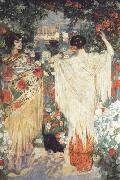 |
Pedro Blanes
|
|
1878-1926
Uruguayan painter. He first studied painting and drawing as a child with the Catalan painter Miguel Jaume i Bosch. As an adolescent he moved with his family to Spain, where he studied at the Real Academia de Bellas Artes de San Fernando in Madrid and frequented the workshop of Santiago Rusieol. After studying in Paris with Benjamin Constant, he visited Italy and Mallorca, where he first developed his talents as a landscape painter before returning briefly to Uruguay in 1899. During another prolonged visit to Europe from 1902 to 1907 he enthusiastically studied the work of Pierre Puvis de Chavannes, Lucien Simon, Henri Martin, Claude Monet and James Abbott McNeill Whistler. After his return to Montevideo in 1907 he painted shimmering Impressionist-influenced landscapes such as Palma de Mallorca and treated local rural and urban scenes in which he established himself as a remarkable colourist. He also commemorated subjects from Latin American history in works such as Artigas Dictating to his Secretary Don Jose G. Monterroso , the equestrian portrait of General Galarza and Artigas in el Hervidero. |
|
|
|
|
|
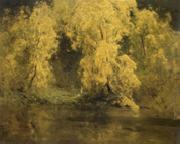 |
Penleigh boyd
|
|
Australia artist
1890-1923
was an Australian artist. Penleigh Boyd was a member of the Boyd artistic dynasty: his parents Arthur Merric Boyd (1862-1940) and Emma Minnie Boyd (n??e ?? Beckett) were well-known artists of the day, and his brothers included Merric Boyd the ceramacist (1888-1959) and the novelist Martin Boyd (1893-1972). His son Robin Boyd (1919-1971) was a noted writer and architectural critic, and his nephews Arthur Boyd and David Boyd became prominent artists. Born in England at Penleigh House, Westbury, Wiltshire, Boyd received his artistic training from his parents and at the National Gallery Art School. He had his first exhibition at the Victorian Artists' Society at 18, and exhibited at the Royal Academy in London at 21. He won second prize in the Australian Federal Government's competition for a painting of the site of the new national capital, Canberra. He won the Wynne Prize in 1914 with Landscape. He served in the AIF (Australian Infantry Forces) in France in World War I, and was invalided out after being badly gassed at the battle of Ypres in 1917. His career was cut short when he was killed in a car accident near Warragul, Victoria in 1923. Penleigh Boyd is best known as a landscapist with an accomplished handling of evanescent effects of light. A notable influence was artist E. Phillips Fox, who introduced him to plein air techniques when they were neighbours in Paris in 1912-1913. |
|
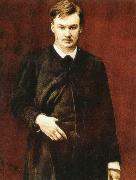 |
percy bysshe shelley
|
|
Born: 4 August 1792
Birthplace: Near Sussex, England
Died: 8 July 1822 (drowning)
Best Known As: 19th century romantic poet
|
|
|
|
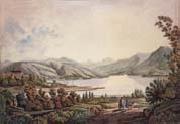 |
Peter Birmann
|
|
Swiss, 1758-1844,He began his career as a portrait painter in Basle and Pruntrut but in 1775 moved to Berne, where he took up landscape painting. From 1777 to 1781 he worked with Johann Ludwig Aberli and was also a colour-printer with the publisher Abraham Wagner (1734-82). In 1781 he went to Rome, where he remained for ten years working for Louis Ducros and for Giovanni Volpato. While in Rome he painted landscapes in watercolour and drew in bistre, using a soft brush and making little use of the pen. He also sketched in the Alban Hills, being particularly attracted to the waterfalls at Tivoli and Terni. He became a member of Goethe's circle in Rome, and, under the influence of its members, he adopted Claude as his model. His watercolours and bistre drawings, enlivened by Greco-Roman or contemporary staffage, became more tranquil, more classical in style and increasingly strengthened with pen outlines. In 1792 he returned to Basle to teach. He soon became an art dealer, opened his own shop and set up his own publishing house, and in 1802 he printed his best-known work, a series of aquatints of Voyage pittoresque de Basle ? Bienne par les vallons de Mottiers-Grandval. From 1802 to 1804 he showed at the annual exhibitions of the K?nstlergesellschaft in Zurich, and in 1804 and 1810 in Berne he exhibited work in oils, a medium that was becoming increasingly important for him. In 1805 he was commissioned by the publishing house of Artaria & Co. in Vienna to sketch the scenery in the region of the north Italian lakes. For the next 30 years he continued to paint and draw, but after 1834 he tended to repeat the locales and compositions of his earlier landscapes. |
|
 |
Peter Buell Porter
|
|
(August 14, 1773 - March 20, 1844) was an American lawyer, soldier and politician who served as United States Secretary of War from 1828 to 1829.
He graduated from Yale College in 1791, studied law in Litchfield, Connecticut, was admitted to the bar, and commenced practice in Canandaigua, New York in 1793. He served as clerk of Ontario County from 1797 to 1804 and was a member of the New York State Assembly in 1802 and again in 1828.
In the fall of 1809, Porter moved to Black Rock, New York and was elected as a Democratic-Republican to the Eleventh and Twelfth United States Congresses, serving from March 4, 1809 to March 3, 1813, but declined renomination. During his service in Congress, he was a leading figure among Congressional "war hawks" and Chairman of the Committee that recommended preparation for war with Great Britain. At the same time, from 1810 to 1816, he was a member of the Erie Canal Commission, a commission on inland navigation established in 1810 by the New York state Legislature to survey a canal route from the Hudson River to the Great Lakes.
During the War of 1812, Porter was initially quartermaster general of the New York State Militia from May to October 1812. He participated in and criticized General Alexander Smyth's abortive operations against British Canada in 1812, culminating in a bloodless duel between the two. The historian John R. Elting wrote of the duel, stating "Unfortunately, both missed."[1] He later raised and commanded a brigade of New York militia that incorporated a Six Nations Indian contingent and led his command with distinction. For his actions, he was presented a gold medal under joint resolution of Congress dated November 3, 1814 "for gallantry and good conduct" during the Battle of Chippewa, the Battle of Niagara, and the Battle of Erie.
Porter was Secretary of State of New York from February 1815 to February 1816. He was also elected to the Fourteenth United States Congress. Although his term in Congress began on March 4, 1815, the actual Session began only in December, and he took his seat on December 11, 1815. On January 23, 1816, he resigned, having been appointed a Commissioner under the Treaty of Ghent, which caused a controversy as to the constitutionality of sitting in Congress and holding this commissionership at the same time.
In 1817, his political friends of Tammany Hall printed ballots with his name and distributed them among their followers to vote for Porter for Governor of New York at the special election which was held after the resignation of Governor Daniel D. Tompkins. DeWitt Clinton, the otherwise unopposed candidate, was fiercely hated by the Tammany organization, and Porter received about 1,300 votes although he was not really running for the office. Porter became a regent of the University of the State of New York in 1824, and served in that capacity until 1830.
From May 16, 1828 to March 9, 1829, Porter served as Secretary of War in the Cabinet of President John Quincy Adams, and was an advocate for the removal of Eastern Indians beyond the Mississippi. He moved to Niagara Falls in 1836 and was a presidential elector on the Whig ticket in 1840. He died at Niagara Falls in 1844, and was interred in Oakwood Cemetery. Fort Porter and Porter Avenue at Buffalo were named in his honor. |
|
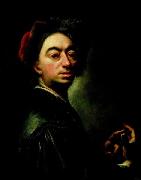 |
Peter Johannes Brandl
|
|
Petr Brandl (Peter Johannes Brandl or Jan Petr Brandl) (October 24, 1668 - September 24, 1735) was a painter of the late Baroque, famous in his time but - due to isolation behind the Iron Curtain - rather forgotten until recently. He was of German-speaking Austrian descent in the bilingual kingdom of Bohemia. His mother was from Czech peasant family, that lived in Přestanice (a village in Bohemia, now part of Hlavnovice). According to the Grove Dictionary of Art and other sources, Brandl was born into a craftsmanes family (his father seems to have been a goldsmith) and apprenticed around 1683 - 1688 to Kristien Schröder (1655 - 1702).
Brandl employed strong chiaroscuro, areas of heavy impasto and very plastic as well as dramatic figures. The major art museum in Prague, called the National Gallery, has an entire hall devoted to the artist's works, including the wonderful "Bust of an Apostle" from some time before 1725. |
|
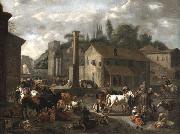 |
Peter van Bloemen
|
|
Pieter van Bloemen, called Standaart (bapt. 17 January 1657 - 6 March 1720), first name also spelled Peter or Peeter, was a Flemish painter.
Van Bloemen was born in Antwerp, where he attained the status of master at the age of 17. He then went to Rome, where he remained until 1694, adopting completely Italian manners. In 1699 he became dean of the Guild of Saint Luke in Antwerp. He was the teacher of his younger brother Jan Frans van Bloemen, a highly regarded painter of classical landscapes. The brothers travelled widely together, often collaborating on works, with Pieter taking on the role of figurista in Jan Frans' vedute, a role he also performed for many other artists. |
|
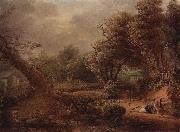 |
Philipp Hieronymus Brinckmann
|
|
(or Brinkman,) a German painter and engraver, was born at Spires in 1709. He was a pupil of J. G. Dathan. His favourite subjects were landscapes, but he also painted historical subjects and portraits; in some of the latter he imitated the force and colouring of Rembrandt. He was painter to the Court, and keeper of the Gallery at Mannheim, where he died in 1761. In the Städel at Frankfort is a 'Swiss Landscape' signed P. H. Brinckmann fecit, 1745. He etched some plates in a picturesque and spirited style. |
|
|
|
 |
Pierre Bonnard
|
|
French Nabi Painter, 1867-1947
French painter, printmaker and photographer. He is known particularly for the decorative qualities of his paintings and his individual use of colour. During his life he was associated with other artists, Edouard Vuillard being a good friend |
|
|
|
|
|
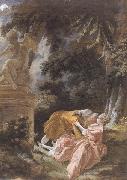 |
Pierre-Antoine Baudouin
|
|
French Painter, 1723-1769
French painter. A pupil of Francois Boucher, whose younger daughter he married in 1758, he specialized in miniatures painted in gouache, which he first exhibited at the Salon of 1761. He was received as a member of the Acad?mie Royale in 1763 with a small gouache of a historical subject, Phryne Accused of Impiety before the Areopagite (Paris, Louvre), and he later painted illustrations of biblical episodes. However, he made his name as a painter of libertine scenes in contemporary settings, which he exhibited regularly at the Salon from 1763 until 1769. Some of his work is directly inspired by Boucher's scenes of pastoral love, but the ostensibly moral themes and careful attention to detail of such paintings as the Modest Model (exh. Salon 1769; Washington, DC, N.G.A.) demonstrate that he was also influenced by Jean-Baptiste Greuze. His pictures were condemned for their immorality, both by the Archbishop of Paris, who in 1763 and 1765 ordered that works by Baudouin be withdrawn from the Salon, and also by Denis Diderot and other critics who accused him of pandering to the decadent taste of his patrons. Nevertheless, Baudouin was one of the most popular artists of the last decades of the ancien regime. |
|
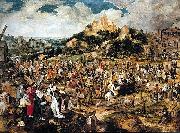 |
Pieter Balten
|
|
Pieter Balten (born ca. 1525 in Antwerp - died 1584 in Antwerp) was a Flemish Renaissance painter.
According to Karel van Mander he became a member of the Guild of St. Luke in 1559 and was a follower of Pieter Bruegel the Elder. He was a good poet and rederijker, who collaborated from time to time with Cornelis Ketel. |
|
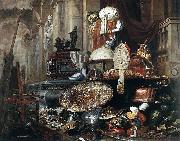 |
Pieter Boel
|
|
(1626-1674) was a Flemish Baroque painter who specialised in lavish still lifes.
Boel was born in Antwerp. He probably went to Italy in 1650. In 1668, he worked for Charles Le Brun (1619-1690) in his first tapestry making studio. According to Arnold Houbraken, whose source was his picture in Cornelis de Bie's book Het Gulden Cabinet, he specialized in painting animals. He died in Paris. |
|
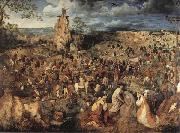 |
Pieter Bruegel
|
|
c.1525-69
Greatest Netherlandish painter of the 16th century. Not much is known of his early life, but in 1551 he set off for Italy, where he produced his earliest signed painting, Landscape with Christ and the Apostles at the Sea of Tiberias (c. 1553). Returning to Flanders in 1555, he achieved some fame with a series of satirical, moralizing prints in the style of Hiëronymus Bosch, commissioned by an Antwerp engraver. He is best known for his paintings of Netherlandish proverbs, seasonal landscapes, and realistic views of peasant life and folklore, but he also took a novel approach to religious subject matter, portraying biblical events in panoramic scenes, often viewed from above. He had many important patrons; most of his paintings were commissioned by collectors. In addition to many drawings and engravings, about 40 authenticated paintings from his enormous output have survived. |
|
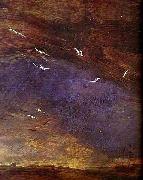 |
Pieter Bruegel the Elder
|
|
(Dutch pronunciation:c. 1525 - 9 September 1569) was a Flemish Renaissance painter and printmaker known for his landscapes and peasant scenes (Genre Painting). He is sometimes referred to as "Peasant Bruegel" to distinguish him from other members of the Brueghel dynasty, but is also the one generally meant when the context does not make clear which "Bruegel" is being referred to. From 1559 he dropped the 'h' from his name and started signing his paintings as Bruegel.
There are records that he was born in Breda, Netherlands, but it is uncertain whether the Dutch town of Breda or the Belgian town of Bree, called Breda in Latin, is meant. He was an apprentice of Pieter Coecke van Aelst, whose daughter Mayken he later married. He spent some time in France and Italy, and then went to Antwerp, where in 1551 he was accepted as a master in the painter's guild. He traveled to Italy soon after, and then returned to Antwerp before settling in Brussels permanently 10 years later. He received the nickname 'Peasant Bruegel' or 'Bruegel the Peasant' for his alleged practice of dressing up like a peasant in order to mingle at weddings and other celebrations, thereby gaining inspiration and authentic details for his genre paintings. He died in Brussels on 9 September 1569 and was buried in the Kapellekerk. He was the father of Pieter Brueghel the Younger and Jan Brueghel the Elder. Both became painters, but as they were very young children when their father died, it is believed neither received any training from him. |
|
 |
Pieter Brueghel the Younger
|
|
(1564 or 1565 - 10 October 1636) was a Flemish painter, known for numerous copies after his father Pieter Brueghel the Elder's paintings and nicknamed "Hell Brueghel" for his fantastic treatments of fire and grotesque imagery.
Pieter Brueghel the Younger was the oldest son of the famous sixteenth-century Netherlandish painter Pieter Brueghel the Elder (known as "Peasant Brueghel") and Mayken Coecke van Aelst. His father died in 1569, when Pieter the younger was only five years old. Then, following the death of his mother in 1578, Pieter, along with his brother Jan Brueghel the Elder ("Velvet Brueghel") and sister Marie, went to live with their grandmother Mayken Verhulst (widow of Pieter Coecke van Aelst). She was an artist in her own right, and according to Carel van Mander, possibly the first teacher of the two sons. The family moved to Antwerp sometime after 1578 and Pieter possibly entered the studio of the landscape painter Gillis van Coninxloo (1544 - 1607). In the 1584/1585 registers of Guild of Saint Luke, "Peeter Brugel" is listed as an independent master. On 5 November 1588 he married Elisabeth Goddelet, and the couple had seven children.
He painted landscapes, religious subjects and fantasy paintings. For this last category he often made use of fire and grotesque figures, leading to his nickname "Hell Brueghel".
Apart from these paintings of his own invention, Pieter Brueghel the Younger also copied the works his father had created by using a technique called pouncing. His genre paintings of peasants lack Pieter the Elder's subtlety and humanism, and emphasize the picturesque
|
|
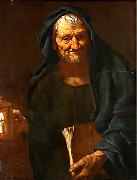 |
Pietro Bellotti
|
|
(1625-1700) was an Italian painter active in the Baroque period. He was born in Sale. He was a pupil of Michele Ferrabosco in Venice. He was patronized by Pope Alexander VIII and by the Duke of Uceda. He lived in Bolzano[1]. He painted mostly portraits. He died at Venice.
|
|
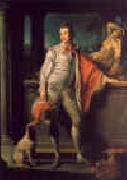 |
Pompeo Batoni
|
|
Italian
1708-1787
Pompeo Batoni Location
Italian painter and draughtsman. In his day he was the most celebrated painter in Rome and one of the most famous in Europe. For nearly half a century he recorded the visits to Rome of international travellers on the GRAND TOUR in portraits that remain among the most memorable artistic accomplishments of the period. He was equally gifted as a history painter, and his religious and mythological paintings were sought after by the greatest princes of Europe. |
|
|
|
|
|
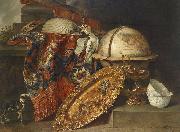 |
R. v. Bohnlich
|
|
R v Bohnlich (fl.c.1880)
19th Century Paintings and Watercolours
|
|
|
|
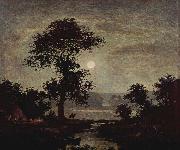 |
Ralph Albert Blakelock
|
|
(October 15, 1847 - August 9, 1919) was a romanticist painter from the United States.
Ralph Blakelock was born in New York City on October 15, 1847. In 1864, Blakelock entered the Free Academy of the City of New York (now known as the City College) with aspirations of becoming a physician. After his third term he opted to dismiss his formal education and left college. From 1869-71 he traveled west, extensively wandering far from known civilization and spending time among the American Indians. Largely self-taught as an artist, he began producing competent landscapes, depicting select views from his travels, as well as scenes of American Indian life. His works were exhibited in the National Academy of Design.
Moonlight, 1885, the Brooklyn MuseumIn 1877 Blakelock married Cora Rebecca Bailey; they had nine children. In art, Blakelock was a genius, yet, in business dealings and in monetary transactions he proved a failure. He found it difficult, if not crushing to maintain and support his wife and children. In desperation he found himself selling his paintings for extremely low prices, far beneath their known worth. In hopes of lifting his family from abject poverty, reportedly on the day his 9th child was born, Blakelock had offered a painting to a collector for $1000. The collector made a counter offer and after refusing the proposed sum Blakelock found himself in a bitter argument with his wife. After the domestic dispute, Blakelock returned to the patron and sold the painting for a much lesser sum. Defeated and frustrated, it is said he broke down and tore the cash into pieces. And so it was after such repeated failed business transactions that he began to suffer from extreme depression and eventually show symptoms of mental frailty. In 1899 he suffered a breakdown. |
|
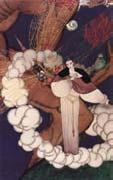 |
Ralph Barton
|
|
American Artist, 1891-1931
American Artist, 1891-1931,1921 Vanity Fair caricature; use cursor to identify figuresBarton's first caricature was of Thomas Hart Benton; his last, of Charlie Chaplin. In between he knew everyone and drew everyone in the social and culture scene of New York. Some of his most famous works were group drawings, and perhaps the most noted was a stage curtain created for a 1922 revue, depicting an "audience" of 139 faces looking back at the real theater-goers. "The effect was electrifying, and the applause was great," said another caricaturist of the era, Aline Fruhauf. He also directed a short film, Camille, described by an IMDB contributor as a "home movie version" of the Dumas novel with a cast of his many actor, artist, and other celebrity friends.This movie was made available as a bonus in a 2003 release of Chaplin's A Woman of Paris. At the height of his popularity, Barton enjoyed not only the acquaintance of the famous, but a solid and impressive income. All of this concealed a terribly unhappy life. He was beset by manic-depressive disorder, and each of his four marriages ended in divorce. A self-portrait, painted around 1925 and modeled on an el Greco. |
|
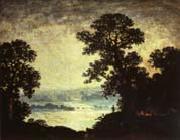 |
Ralph Blakelock
|
|
American Painter, 1847-1919
One of the most important visionary artists in late 19th-century America, he was self-taught as a painter. From 1867 he was exhibiting landscapes in the style of the Hudson River school at the National Academy of Design in New York. Rather than going abroad for advanced training, like most of his contemporaries, he spent the years 1869-72 in the western United States. Back in New York, Blakelock evolved his personal style during the 1870s and 1880s. Eschewing literal transcriptions of nature, he preferred to paint evocative moonlit landscapes such as Moonlight (Washington, DC, Corcoran Gal. A.). |
|
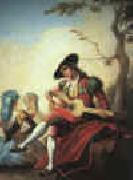 |
Ramon Bayeu
|
|
1746-1793
Spanish
Ramon Bayeu Gallery
The biography of Jose del Castillo (Madrid, 14.10.1737-Madrid, 5.10.1793) shows that the artist, being in his youth one of the most appropriate painters for becoming a leader of the artistic movement of the Illustrious Absolutism, ends up performing secondary work, paintings for tapestry and some religious works of art, which was not the field where he could best display his talent. Jose del Castillo is a perfect example of how an unhappy destiny can influence on the professional life of a painter under the regime of that time. Surely the unhappy destiny, in point of fact, does not explain anything and we will have to find out the real reasons why one of the most promising careers in painting of the eighteenth century in Spain was crushed. Probably it was a combination of two unsuccessful elections, from our point of view, that excluded the figure of Jose del Castillo from the elite group of artists of that time. |
|
 |
Reinhold Begas
|
|
1831-1911 Berlin,was a German sculptor. Begas was born in Berlin to the painter Karl Begas. He received his early education (1846-1851) studying under Christian Daniel Rauch and Ludwig Wilhelm Wichmann. During a period of study in Italy, from 1856 to 1858, he was influenced by Arnold Bocklin and Franz Lenbach in the direction of a naturalistic style in sculpture. This tendency was marked in the group Borussia, executed for the facade of the exchange in Berlin, which first brought him into general notice. In 1861 Begas was appointed professor at the art school at Weimar, but retained the appointment only a few months. That he was chosen, after competition, to execute the statue of Schiller for the Gendarmenmarkt in Berlin, was a high tribute to the fame he had already acquired; and the result, one of the finest statues in the German metropolis, entirely justified his selection. Since the year 1870, Begas dominated the plastic art in the Kingdom of Prussia, but especially in Berlin. Among his chief works during this period are the colossal statue of Borussia for the Hall of Glory; the Neptune fountain in bronze on the Schlossplatz; the statue of Alexander von Humboldt, all in Berlin; the sarcophagus of Emperor Frederick III in the mausoleum of the Church of Peace at Potsdam |
|
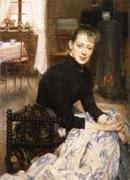 |
Richard Bergh
|
|
1858?C1919,Painter, writer and museum director, son of Edvard Bergh. He studied in Stockholm, first at the art school of Edvard Pers?us (1841-90) and from 1878 to 1881 at the Konstakademi, where he met Nils Kreuger and Karl Nordstrem. His early work consists mainly of academically treated scenes from Swedish history and legend. In 1881 he left for France, studying in Paris with Jean-Paul Laurens and at the Academie Colarossi (1881-4); he made his debut at the Salon of 1883. In 1885, with Ernst Josephson and other members of the Scandinavian artists' colonies in Paris and Grez-sur-Loing, he became one of the main promoters of the Opponenterna, a movement of protest against the conservative attitudes of the Konstakademi; the following year this group formed the Konstnersferbund (Artists' Union), of which Bergh was a leading member throughout his life. |
|
 |
Richard Brakenburgh
|
|
(1650, Haarlem - 1702, Haarlem), was a Dutch Golden Age painter.
According to Houbraken he was a light-hearted poet from Haarlem. He was the pupil of Hendrik Mommers who went on to paint clever genre scenes in the manner of Adriaen van Ostade. Though some said he was the pupil of Bernard Schendel, they were the same age and painted in similar styles. He was successful enough at his art that his Frisian widow was able to purchase an annuity after his death in Friesland.
According to the RKD he is registered in Leeuwarden during the years 1670-1687.He is known for both Italianate landscapes and portraits. He painted similar subjects to those of Schendel, representing merry-makings and drunken assemblies. His pictures are ingeniously composed, and well coloured, something in the manner of Adriaan van Ostade, though greatly inferior. They are painted with facility, although they have the appearance of being very highly finished; and he perfectly understood the management of chiaroscuro. His greatest defect is his incorrect drawing of the figure, which he appears not to have studied from nature. The Vienna Gallery has two 'Peasant Scenes' by him, said to have been painted in 1690; the Berlin Museum one, and the Amsterdam Gallery one. In the Brussels Gallery is a 'Children's Feast,' signed and dated 1698; and the Rotterdam Museum has a 'Doctor's Visit,' signed and dated 1696. In Windsor Castle are two good 'Artists' Studios ' by him. He also sometimes practised the art of engraving.
He was the teacher of Wigerus Vitringa, Abraham Pardanus, and Gillis de Winter. He was followed by Jan Steen and Bernardus van Schijndel. He died at Haarlem in December 1702 and was buried in January 1703.
|
|
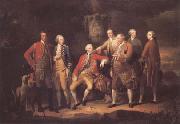 |
Richard Brompton
|
|
1734-1783
English painter. He trained in London with Benjamin Wilson before going to Rome in 1757, where he studied with Anton Raphael Mengs. In Rome he met Charles Compton, 7th Earl of Northampton, who paid him an allowance and in Venice in 1763 introduced him to Edward Augustus, Duke of York. The Duke commissioned a conversation piece of himself and his travelling companions (version, 1764; London, Kew Pal., Royal Col.). The figures are awkwardly posed, but the polished elegance of each shows the influence of Mengs. In 1765 Brompton returned to London with Nathaniel Dance and established a good practice with small-scale works in the manner of Johann Zoffany, such as William Pitt, 1st Earl of Chatham (1772; Chevening, Kent), which exists in several versions. He also produced portraits on a larger scale, including the enormous Henry Dawkins with his Family (1773; Over Norton Hall, Oxon). |
|
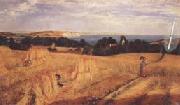 |
Richard Burchett
|
|
British painter and art teacher , (1815-1875)
was a British artist and educator on the fringes of the Pre-Raphaelite movement, who was for over twenty years the Headmaster of what later became the Royal College of Art. He was later described as "a prominent figure in the art-schools, a well instructed painter, and a teacher exceptionally equipped with all the learning of his craft" by his ex-pupil, the poet Austin Dobson. Burchett's pupils included the extremely varied talents of Kate Greenaway, Christopher Dresser, Elizabeth Thompson (Lady Butler), Sir George Clausen, Sir Luke Fildes, Gertrude Jekyll, Hubert von Herkomer, William Harbutt and Helen Allingham. Princess Louise, Duchess of Argyll, Queen Victoria's daughter, and a talented artist, was also a student.As an artist he achieved some reputation for large history paintings, but View across Sandown Bay, Isle of Wight is seen by modern art historians as his best work. |
|
|
|
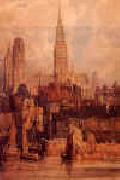 |
Richard Parkes Bonington
|
|
1802-1828
Richard Parkes Bonington Locations
English painter. His father, also called Richard (1768-1835), was a provincial drawing-master and painter, exhibiting at the Royal Academy and the Liverpool Academy between 1797 and 1811. An entrepreneur, he used his experience of the Nottingham lace-manufacturing industry to export machinery illegally to Calais, setting up a business there in late 1817 or early 1818. In Calais the young Richard Parkes Bonington became acquainted with Louis Francia, with whom he consolidated and expanded whatever knowledge of watercolour technique he had brought with him from England. Under Francias direction Bonington left Calais for Paris where, probably not before mid- or late 1818, he met Eugene Delacroix. The latters recollection of Bonington at this time was of a tall adolescent who revealed an astonishing aptitude in his watercolour copies of Flemish landscapes. Once in Paris Bonington embarked on an energetic and successful career, primarily as a watercolourist. In this he was supported by his parents who sometime before 1821 also moved to Paris, providing a business address for him at their lace company premises. |
|
|
|
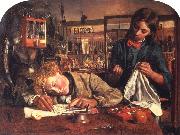 |
Robert Braithwaite Martineau
|
|
English genre and portrait Painter, 1826-1869
was an English painter. He first trained as a lawyer and later entered the Royal Academy where he was awarded a silver medal. He studied under Pre-Raphaelite artist William Holman Hunt and once shared a studio with him. He died at the age of 43. He married Maria Wheeler and had two children with her. His most famous painting, "The Last Day in the Old Home" portrays a man who has brought ruin upon his family and can be seen at the Tate Gallery in London. Other paintings were bequeathed to the Ashmolean Museum in Oxford and Liverpool Art Gallery by his daughter Helen. Other less well known paintings include "Kit's First Writing Lesson" and "Picciola". |
|
|
|
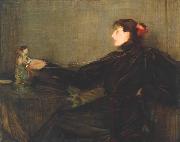 |
Robert Brough
|
|
(1872 - 21 January 1905) was a Scottish painter born in Invergordon, Ross and Cromarty.
He was educated in Aberdeen, and, whilst apprenticed for over six years as lithographer to Messrs Gibb & Co., attended the night classes at Gray's School of Art. He then entered the Royal Scottish Academy, and in the first year took the Stuart prize for figure painting, the Chalmers painting bursary, and the Maclame-Walters medal for composition.
After two years in Paris under J. P. Laurens and Benjamin-Constant at Julian's atelier, he settled in Aberdeen in 1894 as a portrait painter and political cartoonist. A portrait of Mr. W. D. Ross first drew attention to his talent in 1896, and in the following year he scored a marked success at the Royal Academy with his Fantaisie en Folie, which he bequeathed to the National Gallery of British Art (now the Tate gallery). Two of his paintings, Twixt Sun and Moon and Childhood of St. Anne of Brittany, were at the Venice municipal gallery. Brough's art was influenced by Henry Raeburn and by modern French training, but it strikes a very personal note.
Brough died from injuries received in a railway disaster in 1905.
|
|
 |
Robert Frederick Blum
|
|
Major figure painter and illustrator
American , 1857-1903
was an American artist born in Cincinnati, Ohio, on the 9th of July 1857. He was employed for a time in a lithographic shop, and studied at the McMicken Art School of Design in Cincinnati, and at the Pennsylvania Academy of Fine Arts in Philadelphia, but he was practically self-taught, and early showed great and original talent. He settled in New York in 1879, and his first published sketches of Japanese jugglers appeared in St. Nicholas. His most important work is a large frieze in the Mendelssohn Music Hall, New York, Music and the Dance (1895). His pen-and-ink work for the Century Magazine attracted wide attention, as did his illustrations for Sir Edwin Arnold's Japonica. "Man before grilled entrance"In the country and art of Japan he had been interested for many years. A Daughter of Japan, drawn by Blum and W. J. Baer, was the cover of Scribner's Magazine for May 1893, and was one of the earliest pieces of color printing for an American magazine. In Scribner's for 1893 appeared also his Artist's Letters from Japan. He was an admirer of Fortuny, whose methods somewhat influenced his work. Blum's Venetian pictures, such as A Bright Day at Venice (1882), had lively charm and beauty. He died on the 8th of June 1903 in New York City. |
|
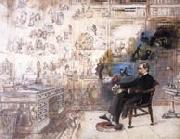 |
Robert William Buss
|
|
British painter and etcher , 1804-1875
was a Victorian artist, etcher and illustrator perhaps best known for his painting Dickens' Dream. Born in Bull and Mouth Street, Aldersgate in London in 1804, Buss served an apprenticeship with his father, a master engraver and enameller, and then studied painting under George Clint, a miniaturist, watercolour and portrait painter, and mezzotint engraver. At the start of his career Buss specialized in painting theatrical portraits, with many of the leading actors of the day sitting to him, including William Charles Macready, John Pritt Harley, and John Baldwin Buckstone. Later Buss painted historical and humorous subjects. He exhibited a total of 112 pictures between 1826 and 1859, twenty-five at the Royal Academy, twenty at the British Institution, |
|
 |
Rosa Bonheur
|
|
1822-1899 Realism,French,French painter and sculptor. She received her training from her father, Raymond Bonheur (d 1849), an artist and ardent Saint-Simonian who encouraged her artistic career and independence. Precocious and talented, she began making copies in the Louvre at the age of 14 and first exhibited at the Salon in 1841. Her sympathetic portrayal of animals was influenced by prevailing trends in natural history (e.g. Etienne Geoffroy Saint-Hilaire) and her deep affinity for animals, especially horses. Bonheur's art, as part of the Realist current that emerged in the 1840s, was grounded in direct observation of nature and meticulous draughtsmanship. She kept a small menagerie, frequented slaughterhouses and dissected animals to gain anatomical knowledge. Although painting was her primary medium, she also sculpted, or modelled, studies of animals, several of which were exhibited at the Salons, including a bronze Study for a Bull and Sheep . |
|
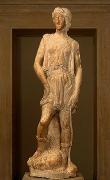 |
ROSSELLINO, Bernardo
|
|
Italian sculptor
Florentine school (b. 1409, Settignano, d. 1464, Firenze).Italian architect and sculptor. Influenced by Donatello, Filippo Brunelleschi, and Luca Della Robbia, he developed a moderately Classical style. His tomb for Leonardo Bruni (1444 C 50) in Santa Croce, Florence, was one of the greatest achievements of early Renaissance sculpture and inaugurated a new type of sepulchral monument. Its fine balance between sculpture and architecture, figure and decoration, made it the prototypical niche tomb of its time. He also designed the apse of St. Peter's Basilica and the cathedral and Piccolomini Palace in Pienza (1460 ?C 64). He presumably trained his brother Antonio (1427 ?C 79), who regularly assisted him.
|
|
|
|
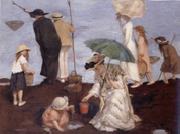 |
Rupert Bunny
|
|
Australian Painter, 1864-1947
Australian painter. After studying in Melbourne under G. F. Folingsby (d 1891), he moved to Europe in 1884 and studied in London under P. H. Calderon and in Paris under Jean-Paul Laurens, who introduced him to the Societe des Artistes Francais in 1887. His early works consisted mainly of mythological subjects and graceful images of pleasant Symbolist landscapes; he defected to the New Salon in 1901 and produced some less decorative works, including images of biblical subjects. A long series of paintings of women followed, but his style again changed abruptly when in 1913 he exhibited at the Salon d'Automne a series of images of dancers, The Rite, that shows the influence of Primitivism. Although not attracted to the avant-garde, Bunny showed an adventurous spirit in his unusual sense of colour, sense of rhythm and witty use of his subjects' poses. He continued to live in Paris and London until 1933. |
|
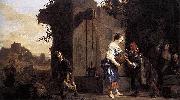 |
Salomon de Bray
|
|
(Amsterdam, 1597 - Haarlem, 11 May 1664) was a Dutch Golden Age architect and painter.
De Bray established himself in Haarlem before 1617, where he is registered as being a member of the schutterij that year in the St. Adrian's cloveniers.[1] He probably followed draftsmanship and painting lessons in the small academy started by Karel van Mander, Hendrick Goltzius and Cornelis van Haarlem, and where he married in 1625. He is registered as a pupil of Goltzius and Cornelis van Haarlem, but he probably started his training in Amsterdam with Jan Pynas, Nicolaes Moeyaert and Pieter Lastman.He painted history paintings, portraits and landscapes. As a Catholic he probably also made altar pieces for the Haarlem underground Catholic churches known as mission stations, or staties. He was a member of the Chamber of rhetoric called "De Wijngaertranken". This is probably how he met his wife Anna, the sister of the painter Jan and the poet Jacob Westerbaen. They married in 1625 and in 1630 he became a member of the Haarlem Guild of St. Luke. He cooperated with fellow Haarlem lukasguild member Jacob van Campen in the decoration of Huis ten Bosch in The Hague. His works draw on the spirit of the Dutch classicism beginning at that time, and are comparable with those of Pieter de Grebber.
Transcription of Salomon de Bray's proposed hierarchy of the guild in 1631. The Haarlem archivist C.J. Gonnet published a book in 1877 on the Haarlem St. Lukasgilde archives. This was meant for historians wishing to do research on Haarlem painting, but who could not read the old handwriting.De Bray was also active as a designer of silverwork, as a poet, as an architect and as a town planner for the city council of Haarlem. He designed an ambitious plan to expand the city on the North side that was partially implemented in the decades after his death. He became headman of the Guild of St. Luke and even prepared a new charter for the guild (that was never ratified) in 1631. As an architect, he was involved in the construction or expansion of Haarlem's City Hall, Zijlpoort, and St. Annakerk (Church of St. Anne), and Nijmegen's city orphanage. One of his poems was set to music by his friend the composer Cornelis Padbru??.
Salomon de Bray was the father of ten children, of whom three (Dirck de Bray, Jan de Bray, and Joseph de Bray) became notable artists. He probably died of the plague that hit Haarlem in 1664, as he and his children Jacob, Josef, Juliana and Margaretha all died in April and May of that year. His wife had already died the previous year. He was buried in the Sint-Bavokerk in Haarlem.
In 1631 Salomon de Bray wrote "Architectura Moderna" which provided a biography and descriptions of buildings built by Hendrick de Keyser, one of the key Dutch architects of the period
|
|
|
|
|

